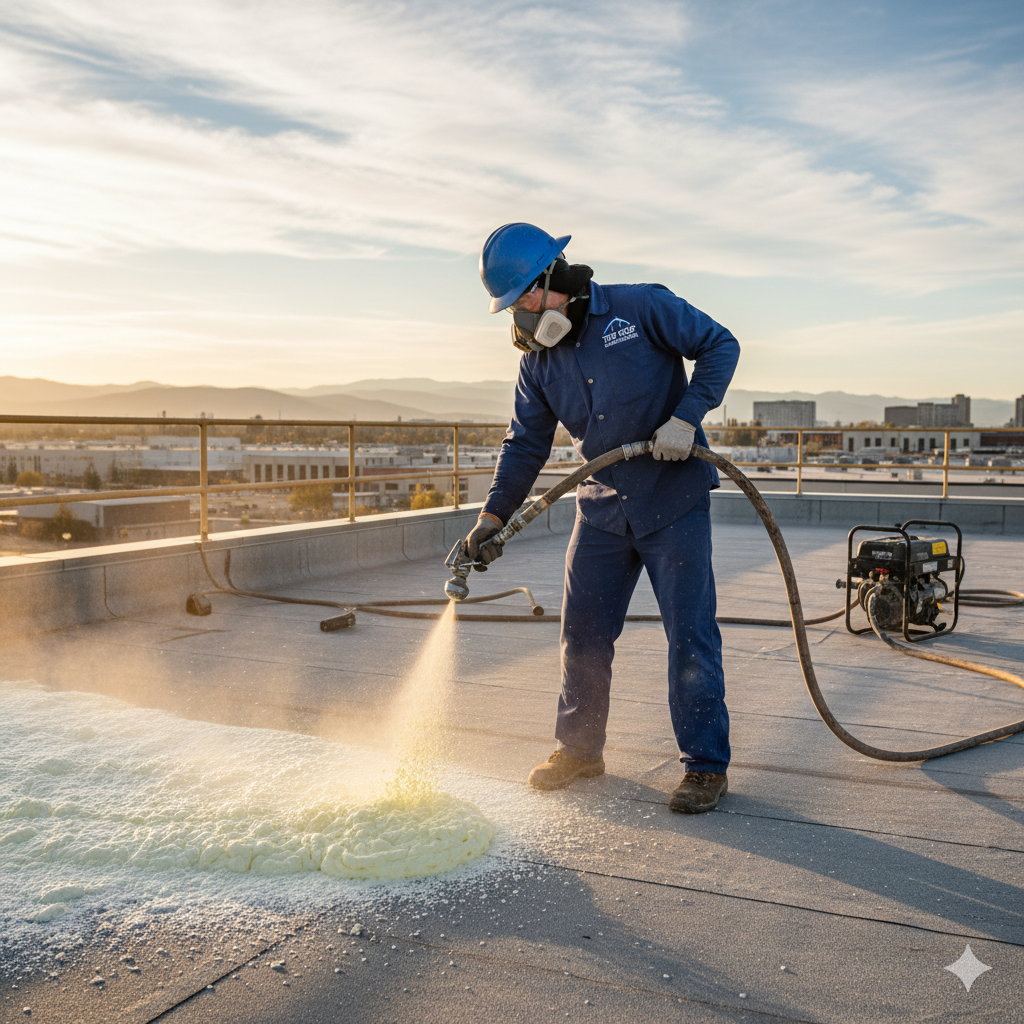
Spray Foam Roofing, also known as SPF (Spray Polyurethane Foam) roofing, is an innovative roofing system gaining popularity in the commercial roofing sector for its seamless application, superior insulation properties, and long-term durability. This blog explores how spray foam roofing works, its advantages, drawbacks, costs, maintenance needs, and its suitability for different climates and commercial building types.
What Is Spray Foam Roofing?
Spray foam roofing is created by spraying a liquid mixture of isocyanate and polyol resin directly onto the roof surface. The two components chemically react to expand into a solid, lightweight foam layer that adheres to the existing roof. Once the foam cures, a protective elastomeric coating (typically silicone or acrylic) is applied to shield it from UV rays and weather damage.
This system can be applied over:
- Existing roofing systems (metal, asphalt, single-ply)
- New construction
SPF roofing is especially effective on flat or low-slope roofs, where waterproofing and energy efficiency are crucial.
Key Benefits of Spray Foam Roofing
1. Seamless and Waterproof
SPF creates a monolithic (seamless) membrane, eliminating joints and gaps where leaks typically occur. It self-adheres to the roof and fills in cracks or gaps in the substrate.
2. Superior Insulation Value
SPF has one of the highest R-values per inch of any roofing insulation—around R-6.5 per inch. This helps reduce energy costs by minimizing heating and cooling loss.
3. Lightweight Yet Durable
The foam adds minimal weight to the structure but provides excellent durability and structural support. Ideal for aging roofs or retrofits where weight is a concern.
4. Sustainable and Environmentally Friendly
SPF roofs can be recoated every 10–20 years without removing the original system, reducing landfill waste. Some formulas are low-VOC and ENERGY STAR certified.
5. Fast Installation and Minimal Disruption
Since SPF can be applied directly over most existing roofs, there’s no need for costly tear-offs. The fast curing process minimizes downtime for businesses.
6. Flexible and Self-Flashing
SPF easily adapts to irregular shapes, penetrations, or slopes, making it ideal for complex roof geometries. It naturally forms flashing around vents and HVAC units.
Drawbacks and Considerations
While SPF roofing has many benefits, there are a few important drawbacks to keep in mind:
- Weather-dependent installation: Can only be applied in dry, warm conditions (typically above 50°F)
- UV sensitivity: Requires a protective coating to prevent UV degradation
- Skilled installation needed: Requires experienced, certified installers for proper application
- Initial cost: Higher upfront than some alternatives, though it pays off over time through energy savings and longevity
Spray Foam Roofing vs. Other Commercial Roof Systems
| Feature | Spray Foam (SPF) | TPO | EPDM | PVC |
| R-Value per inch | R-6.5 | R-3.0 | R-3.0 | R-3.0 |
| Seamless | Yes | No | No | No |
| Leak Resistance | Excellent | Good | Good | Excellent |
| Installation Speed | Fast | Moderate | Fast | Moderate |
| Maintenance | Low | Low | Low | Low |
| Lifespan | 20–30 years+ | 20–30 years | 30–50 years | 20–30 years |
Cost of Spray Foam Roofing
The average cost of SPF roofing ranges from $5 to $12 per square foot installed, depending on:
- Roof size and shape
- Foam thickness and coating type
- Labor and regional material costs
Though more expensive than traditional flat roofing upfront, the high insulation value and long-term performance often result in lower lifetime costs.
Ideal Applications for Spray Foam Roofing
SPF roofing is especially suitable for:
- Commercial buildings with large flat roofs
- Facilities requiring high energy efficiency (warehouses, schools, hospitals)
- Buildings with irregular or complex rooftop layouts
- Aging roofs that need restoration without tear-off
It’s also a strong option in areas with high solar exposure, wide temperature swings, or frequent rainfall.
Maintenance and Longevity
SPF roofing can last 20 to 30 years or more when properly maintained. Maintenance tips include:
- Annual inspections
- Recoating every 10–20 years depending on wear
- Prompt repair of punctures or blisters
When well-maintained, SPF roofing can be recoated indefinitely, extending the roof’s life almost indefinitely.
Is Spray Foam Roofing Right for Your Business?
If you want a high-performance, energy-saving roofing system that adapts to your building’s needs, SPF roofing is an excellent choice. While it requires a skilled installer and has weather limitations, the long-term return on investment, durability, and waterproofing benefits make it one of the smartest options for commercial properties.
Need Spray Foam Roofing Installation or Repair?
Hostetler Roofing provides professional spray foam roofing services for commercial buildings. Whether it’s a new installation or restoration, our certified team ensures precision, efficiency, and durability you can count on. Call (870)-557-4797 today to request a free roof inspection or project estimate.
You May Also Like To Read: Why PVC Roof Membrane is the Best Energy-Efficient Choice for Commercial Roofs

